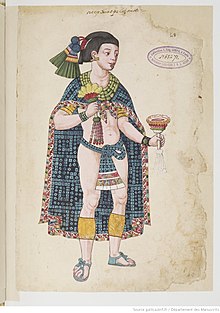
Back Tlahtoani BAR Tlatoani BCL Тлатаані Byelorussian Tlatoani Breton Tlatoani Czech Tlatoani German Tlatoani Esperanto Tlatoani Spanish Tlatoani French Tlatoani Galician

| Tlahtoāni of Aztec Empire | |
|---|---|
 Sacred war emblem | |
| Details | |
| Style | Huēyi tlahtoāni |
| First monarch | Acamapichtli |
| Last monarch | Cuauhtémoc |
| Formation | c. 1376 |
| Abolition | 1521 |
| Residence | Tenochtitlan |
| Appointer | Council of Elders |
Tlahtoāni[1] (Classical Nahuatl: tlahtoāni pronounced [t͡ɬaʔtoˈaːniˀ] , "ruler, sovereign"; plural tlahtohqueh[2] [t͡ɬaʔˈtoʔkeʔ]) is a historical title used by the dynastic rulers of āltepēmeh (singular āltepētl, often translated into English as "city-state"), autonomous political entities formed by many pre-Colombian Nahuatl-speaking peoples in the Valley of Mexico during the Postclassic Period. The title of huēyi tlahtoāni ([ˈweːjiˀ t͡ɬaʔtoˈaːniˀ], "great ruler, emperor") was used by the rulers of the Aztec Empire, an alliance between the āltepēmeh of Tenochtitlan, Tetzcoco, and Tlacopan.[3]
Each āltepētl had its own tlahtoāni who would concurrently function as its ruler, high priest and commander-in-chief. The tlahtoāni wielded ultimate authority over all land within the āltepētl, overseeing tribute collection, market activities, temple affairs, and the resolution of judicial disputes.[4] Typically a dynastic ruler hailing from the royal lineage, the tlahtoāni served for life. However, in certain instances, a council of nobles, elders, and priests could elect a tlahtoāni from a pool of four candidates.[5]
- ^ The term is commonly spelled tlatoani, as frequently utilized in historical Spanish and Nahuatl documents from the colonial period, as well as in contemporary Spanish usage, whence the term came into English.
- ^ Frequently spelled tlatoque, omitting the indication of the saltillo (glottal stop), represented by the letter ⟨h⟩ in certain contemporary sources and modern academic references.
- ^ Lockhart (2001, p.238); Schroeder (2007, p.3), who pre. See also the entry for "TLAHTOANI" Archived 2007-06-14 at the Wayback Machine, in Wimmer (2006)
- ^ "Aztec Political Structure". Tarlton Law Library. Retrieved 10 March 2020.
- ^ "pre-Columbian civilizations". Encyclopædia Britannica. 2016-11-22. Retrieved 2017-05-22.
© MMXXIII Rich X Search. We shall prevail. All rights reserved. Rich X Search